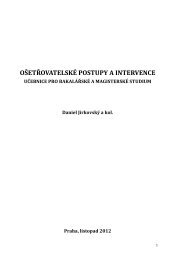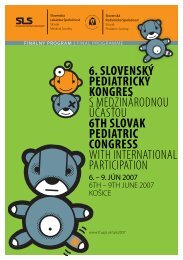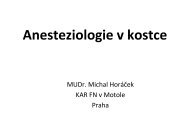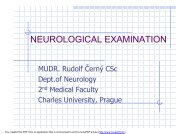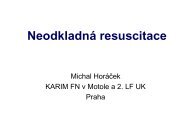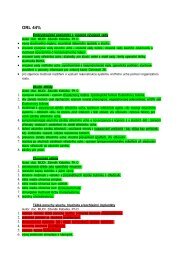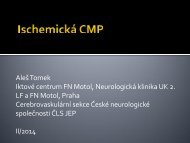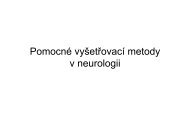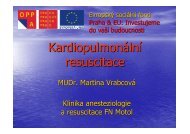Epilepsy and Epileptic Seizures
Epilepsy and Epileptic Seizures
Epilepsy and Epileptic Seizures
You also want an ePaper? Increase the reach of your titles
YUMPU automatically turns print PDFs into web optimized ePapers that Google loves.
<strong>Epilepsy</strong> <strong>and</strong> <strong>Epileptic</strong> <strong>Seizures</strong><br />
Petr Marusič<br />
Dpt. of Neurology<br />
Charles University in Prague<br />
2nd Faculty of Medicine<br />
Motol University Hospital
<strong>Epilepsy</strong><br />
• Spontaneously recurring epileptic seizures<br />
• One of most common CNS diseases<br />
• Prevalence: 0.5-1%<br />
– Czech Rep. = 70 000 patients<br />
• Incidence: 50 newly diagnosed/100 000/y<br />
– Czech Rep. = 5000/year
<strong>Epileptic</strong> seizure<br />
• Symptom of brain functional impairment<br />
– acute<br />
– chronic<br />
• Usually short transient change in clinical<br />
status caused by pathological<br />
– increase in neuronal excitation<br />
– decrease in neuronal inhibition<br />
– neuronal hypersynchrony
Diagnosis<br />
Steps<br />
• Differentiation of nonepileptic events<br />
• Seizure classification<br />
• <strong>Epilepsy</strong> classification<br />
– Etiology
Nonepileptic Events<br />
• Somatic<br />
– SYNCOPE<br />
– TIA, migraine, transient global amnesia, metabolic<br />
disorders<br />
• Psychogenic<br />
– DISSOCIATIVE („Pseudoseizures“)<br />
– Panic attack
Syncope<br />
Differentiation from <strong>Epileptic</strong> Seizure<br />
• Onset<br />
• Autonomic signs<br />
• Injury<br />
• Incontinence<br />
• Motor activity – convulsive syncope
Syncope Seizure<br />
Body position Vertical<br />
Independent<br />
Prevalence Awake Awake/Sleep<br />
Color Pale Cyanotic<br />
Aura Non-specific Specific<br />
Confusion Short Prolonged<br />
Automatisms Absent<br />
May occur<br />
EEG Normal Abnormal
Psychogenic <strong>Epileptic</strong><br />
Age of onset Younger Whenever<br />
Provocation Situation Different<br />
Duration Often >5 min. Usually
Hyperventilation Attacks<br />
• Provoked hyperventilation<br />
– Pain, anxiety, psychogenic component<br />
• Mouth <strong>and</strong> h<strong>and</strong>s paresthesia<br />
• H<strong>and</strong>s <strong>and</strong> feet spasm - tetany<br />
• Tx - verbal, drugs<br />
– Breathing into plastic or paper bag<br />
• Other causes of tetany<br />
– Ca, Mg
<strong>Epileptic</strong> Seizure<br />
• Acute symptomatic (provoked) – aetiology<br />
– Cerebral – head injury, stroke, mass lesion - tumor,<br />
encephalitis<br />
– Extracerebral – metabolic disorder, electrolyte<br />
dysbalance, drugs, alcohol/drugs withdrawal<br />
• Recurrent unprovoked - EPILEPSY<br />
• Isolated unprovoked - EPILEPSY
Classification<br />
• SEIZURES<br />
• EPILEPSIES<br />
• Type<br />
– Description<br />
• EEG (interictal)<br />
• Overall clinical<br />
impression<br />
• History<br />
• Seizure type<br />
• EEG<br />
• Imaging
Seizure Classification<br />
– ILAE 1981<br />
• Simple Partial (SPS)<br />
– Consciousness fully preserved<br />
• Complex Partial (CPS)<br />
– Consciousness impaired<br />
• Generalized<br />
– Primary or secondary
Seizure Evolution<br />
Simplex Partial Complex Partial Generalized<br />
• Postparoxysmal period – alteration
Generalized <strong>Seizures</strong><br />
• Absence<br />
• Myoclonic<br />
• Clonic<br />
• Tonic<br />
• Tonic-clonic (GTCS)<br />
• Atonic
Classification<br />
• SEIZURES<br />
• EPILEPSIES<br />
• Type<br />
– Description<br />
• EEG (interictal)<br />
• Overall clinical<br />
impression<br />
• History<br />
• Seizure type<br />
• EEG<br />
• Imaging
Classification<br />
• SEIZURES<br />
• EPILEPSIES<br />
• Type<br />
• EEG<br />
– Description<br />
• Overall clinical<br />
impression<br />
• History<br />
• Seizure type<br />
• EEG<br />
• Imaging
Classification of Epilepsies <strong>and</strong><br />
– ILAE 1989<br />
<strong>Epileptic</strong> Syndromes<br />
• Focal, Localization-related<br />
– Focal brain disorder<br />
• Generalized<br />
– Diffuse disorder
Classification of Epilepsies <strong>and</strong><br />
<strong>Epileptic</strong> Syndromes<br />
• Idiopathic (genetic)<br />
• Symptomatic (structural or metabolic)<br />
• Cryptogenic (unknown aetiology)
Prophylaxis<br />
• No prove of prophylactic effect of antiepileptic<br />
drugs on development of posttraumatic<br />
epilepsy<br />
• Temkin NR, et al. Epilepsia. 1997<br />
• Similar results for other symptomatic<br />
epilepsies
Therapy<br />
• Life style<br />
– Elimination of risk<br />
– Elimination of triggers<br />
• Antiepileptic drugs (AEDs)
Therapy<br />
• Choice of AED<br />
• Titration<br />
• Outcome – efficacy<br />
– <strong>Epilepsy</strong> type dependent<br />
– 70% seizure free<br />
– 30% drug resistant (refractory)<br />
• Discontinuation
Antiepileptic Drugs<br />
• 1. generation = old AEDs<br />
– phenobarbital, primidone, phenytoin, etosuximide<br />
• 2. generation<br />
– carbamazepine, valproate<br />
• 3. generation = new AEDs<br />
– lamotrigine, levetiracetam … <strong>and</strong> others
Choice of AED<br />
• Efficacy<br />
– Type of seizure/syndrome<br />
• Side-effect profile<br />
– Personal history<br />
– Physical status<br />
– Anticipation
Emergency<br />
• 1st seizure<br />
• Cluster of seizures<br />
• Status epilepticus
First Aid<br />
• During seizure<br />
– simple partial<br />
– complex partial<br />
– generalized convulsive<br />
• Following the seizure
Status <strong>Epileptic</strong>us<br />
• Definition<br />
– Historical<br />
– New<br />
• seizure activity lasting 30 minutes without pt. regaining<br />
full consciousness between seizures<br />
• seizure lasting longer than 5 minutes = low chance for<br />
spontaneous termination<br />
• 2nd seizure within 30 minutes without regaining full<br />
consciousness between seizures
Treatment<br />
• Airways<br />
– Obstruction<br />
– Head position<br />
• Oxygen<br />
• IV line - laboratory testing<br />
– Blood sugar<br />
• Vital signs monitoring
Therapy<br />
• Diazepam 10-20 mg IV or rectal<br />
– Repeat if effective after 10-15 minutes<br />
– Hypotension, respiratory failure<br />
• Alternatively<br />
– Midazolam (Dormicum) 5-15 mg IV or IM<br />
– Clonazepam (Rivotril) 1-2 mg IV<br />
• Phentyoin 15-20 mg/kg IV = +/- 4 amp.<br />
– Slow saturation ! - 50 mg/min - ECG monitor
<strong>Epilepsy</strong> <strong>and</strong> Pregnancy<br />
• Higher risk for mother <strong>and</strong> child (fetus)<br />
– <strong>Seizures</strong><br />
– Teratogenicity<br />
• Most epilepsy women have<br />
– Normal pregnancy <strong>and</strong> delivery<br />
– No change in seizure frequency<br />
• Breast feeding generally not contraindicated
Psychiatric Comorbidities <strong>and</strong><br />
Psychosocial Aspects<br />
• Psychiatric comorbidity<br />
– Anxiety, depression, psychosis<br />
• Stigma of having epilepsy<br />
• Employment issues<br />
• Driving<br />
• Therapeutic outcome<br />
– Seizure frequency<br />
– Seizure-free period



